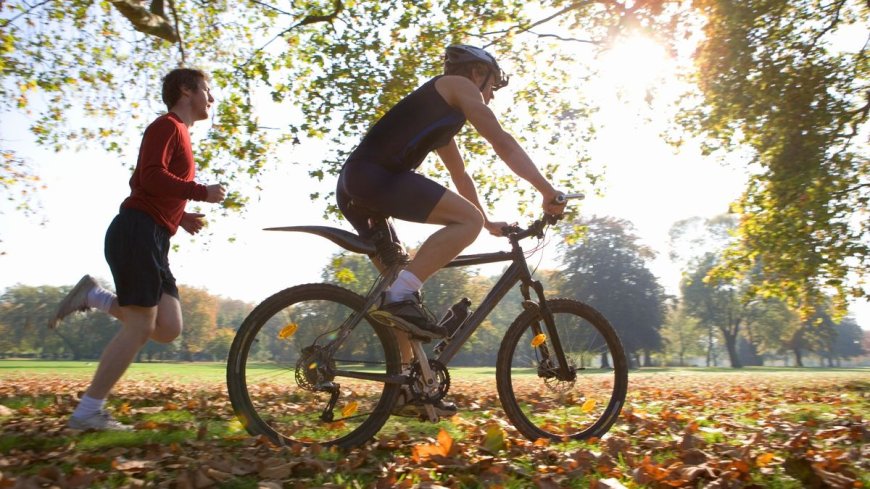Is Cycling Good for Weight Loss? Benefits, Tips, and Results
Discover how cycling supports weight loss, burns calories, and builds muscle. Learn the key benefits, tips for success, and expected results of cycling for fat loss.

When it comes to shedding extra pounds and improving overall fitness, cycling is one of the most accessible and effective exercises out there. Whether you're cruising through city streets, pedaling on country roads, or spinning in a gym, cycling offers a powerful combination of calorie burn, muscle engagement, and cardiovascular benefits.
But is cycling really good for weight loss? In this comprehensive guide, well explore how cycling helps with weight management, what results you can expect, and how to maximize your efforts on two wheels.
Why Choose Cycling for Weight Loss?
Cycling is a low-impact, full-body cardiovascular workout that can be tailored to all fitness levels. Heres why its a top choice for weight loss:
1. Burns Calories Effectively
The number of calories burned during cycling depends on factors like intensity, speed, weight, and terrain. On average:
-
A person weighing 155 pounds can burn approximately 250500 calories in 30 minutes of cycling.
-
Cycling at a faster pace or uphill can increase this burn significantly.
2.Boosts Metabolism
Regular cycling not only burns calories during the ride but also increases your resting metabolic rate. This means your body continues to burn more calories even after your workout is over.
3. Engages Major Muscle Groups
Cycling works the glutes, quadriceps, hamstrings, calves, and core. Toned muscles burn more calories at rest, which contributes to fat loss and better body composition over time.
4. Improves Cardiovascular Health
Weight loss isn't just about aestheticsits about health. Cycling strengthens the heart, improves circulation, and reduces the risk of chronic conditions like diabetes, hypertension, and obesity.
5. Easy on the Joints
Unlike high-impact exercises such as running, cycling is gentle on your joints. This makes it ideal for people with arthritis, joint pain, or those recovering from injury.
How Cycling Helps with Fat Loss
If youre focused on reducing body fat, especially stubborn belly fat, cycling can help when combined with a balanced diet and consistency.
-
Steady-state cardio (like long, moderate rides) burns fat over time.
-
Interval training (alternating between high and low intensity) boosts fat oxidation and improves endurance.
-
Cycling also reduces stress, which helps regulate cortisola hormone linked to fat storage, especially in the abdominal area.
Cycling vs. Other Cardio for Weight Loss
You may wonder how cycling compares to running, swimming, or walking. Here's a quick breakdown:
| Exercise | Calorie Burn (30 min, 155 lbs) | Impact on Joints | Accessibility |
|---|---|---|---|
| Cycling | 250500+ | Low | High (with a bike) |
| Running | 300600+ | High | High |
| Swimming | 200400 | Very Low | Moderate (pool needed) |
| Walking | 150250 | Low | Very High |
Conclusion: Cycling strikes an excellent balance between effectiveness, joint safety, and conveniencemaking it ideal for sustainable weight loss.
Best Types of Cycling for Weight Loss
Not all cycling is equal. Here are the most popular types, along with their benefits:
Outdoor Road Cycling
-
Great for long-distance endurance.
-
Variable terrain and wind resistance increase calorie burn.
-
Provides mental benefits from fresh air and nature.
Stationary or Spin Bike
-
Ideal for high-intensity intervals.
-
Perfect for bad weather or controlled environments.
-
Easier to track metrics like heart rate, resistance, and cadence.
Mountain Biking
Engages more upper body muscles due to terrain and balance demands.
-
Burns more calories because of challenging climbs and rough trails.
Commuter Cycling
-
An easy way to integrate exercise into your daily routine.
-
Even 2030 minutes of riding to work or the store adds up over time.
Tips to Maximize Weight Loss Through Cycling
To see real results, consider these strategies:
1. Ride Consistently
Aim for 35 sessions per week, totaling at least 150300 minutes of moderate-intensity cycling.
2. Mix in Intervals
Add short bursts of high-intensity pedaling followed by slower recovery periods. This method, known as HIIT (High-Intensity Interval Training), accelerates fat loss.
3. Watch Your Diet
Exercise alone wont offset poor eating habits. Focus on:
-
Whole foods
-
Lean proteins
-
Healthy fats
-
Complex carbs
-
Hydration
Avoid excessive sugar, processed foods, and overeating post-ride.
4. Track Your Progress
Use fitness apps or cycling computers to monitor distance, speed, and calories burned. Keeping track helps maintain motivation and identify areas for improvement.
5. Prioritize Recovery
Give your muscles time to recover, especially after intense rides. Adequate rest, stretching, and sleep are vital for fat loss and performance.
Expected Results: What Can You Realistically Achieve?
Weight loss is a gradual process. Heres what you can expect if you're consistent with cycling and maintain a calorie deficit:
-
12 pounds of weight loss per week is a healthy, sustainable goal.
-
Improved muscle tone in your legs, hips, and core.
-
Better stamina and energy levels in daily life.
-
Visible body composition changes within 48 weeks.
Remember, results vary based on your starting weight, effort, and dietary habits.However,Guide for Weight Loss with Cycling?
Common Mistakes to Avoid
Even though cycling is beginner-friendly, some mistakes can slow your progress:
-
Overeating post-workout: It's easy to overestimate calorie burn and compensate with too much food.
-
Ignoring resistance: Riding only on flat roads or low resistance won't challenge your muscles or metabolism enough.
-
Lack of variety: Doing the same route or speed every day can cause plateaus.
-
Skipping strength training: Combine cycling with resistance exercises for maximum fat loss.
Cycling for Life, Not Just for Weight Loss
While cycling is excellent for shedding pounds, the benefits go far beyond the scale:
-
Boosts mental clarity and reduces anxiety
-
Builds community if you join cycling groups or classes
-
Encourages mindfulness and connection with nature
-
Promotes long-term cardiovascular health
Its a sustainable activity that you can enjoy well into your later years.
Q: How much should I cycle to lose weight?
A: To promote weight loss, aim for at least 150 to 300 minutes of moderate-intensity cycling per week. That breaks down to about 3060 minutes, 3 to 5 times a week. Consistency and intensity matter more than duration alone.
Q: Is indoor cycling as effective as outdoor cycling for weight loss?
A: Yes, indoor cyclingespecially spin classes or HIIT-style sessionscan burn just as many calories as outdoor rides. The key is maintaining intensity and varying resistance levels to keep your body challenged.
Q: Can cycling help reduce belly fat?
A: Cycling helps burn overall body fat, including visceral fat around the abdomen. Pairing cycling with a balanced diet, core-strengthening exercises, and stress reduction will enhance your results in reducing belly fat.
Q: Do I need a special diet to lose weight with cycling?
A: While cycling burns calories, a healthy, calorie-controlled diet is essential for effective weight loss. Focus on whole foods, lean proteins, healthy fats, and complex carbs. Avoid overeating after rides to maintain a calorie deficit.
Q: What type of cycling burns the most calories?
A: High-intensity cycling, such as uphill riding, sprint intervals, or fast-paced spin classes, burns the most calories per minute. Mountain biking and long-distance endurance rides can also significantly boost fat loss.
Final Thoughts
So, is cycling good for weight loss? Absolutely. With its calorie-burning power, muscle-building potential, and low impact on joints, cycling is one of the most effective and enjoyable ways to lose weight and keep it off.
Whether you prefer the open road, a quiet trail, or an indoor spin class, cycling offers something for everyone. Stay consistent, challenge yourself, pair it with a balanced diet, and youll see real, lasting results.






































